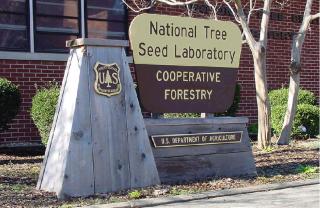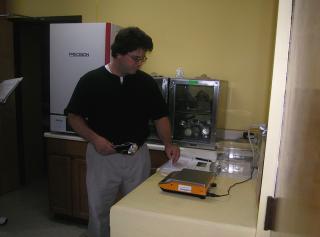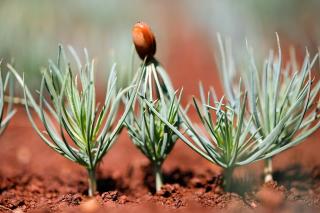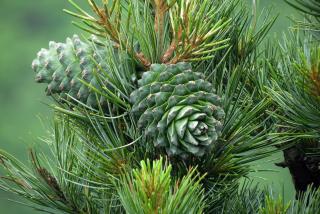National Seed Laboratory

Most native plants used for ecosystem conservation and restoration are propagated exclusively from seeds. Sufficient quantities of seeds are needed to restore and sustain native plant communities that are increasingly affected by invasive species, pest infestations, wildfire, and climate change. The National Seed Laboratory (NSL) is currently addressing these complex challenges and is serving as the primary national strategic resource for forest ecosystem seed science and technology.
The Mission
Worldwide and national interest in planting trees is at an all-time high. Campaigns carried out by such groups as American Forests (Global ReLeaf) and the National Arbor Day Foundation are signs of this high interest. The success of these and other planting programs depends on high-quality seedlings - and good seedlings start with high quality seed. The mission of the National Seed Laboratory is to assist in providing a quality start for global reforestation.
Seed Testing Services
The National Seed Laboratory provides seed testing services to both small and large private firms, state governments, national forests and other federal agencies. The results of these test are used in forest nurseries to determine sowing rates, in seed conditioning plants to evaluate product quality, and by seed dealers to determine price. Read more about our seed testing services.
Genetic Conservation
Some native plant species are at risk due to insects, disease, invasive weeds, overuse by humans, and/or inherent biology. Seeds, from these species, can be conserved for decades. Samples are provided for domestic and international research and sample data is maintained in an internet accessible data base. More on genetic conservation.

Technical Assistance
Technology Adaptation
The National Seed Laboratory is at the forefront in developing new forest seed technology. The latest equipment for seed conditioning and seed testing is evaluated and adapted for use with tree seed. New ideas to improve the seed-to-seedling ratio in forest nurseries are evaluated cooperatively with nursery and reforestation personnel.
Troubleshooting
Tree seed users are assisted in solving their collection, conditioning, handling, testing, and other seed related reforestation problems. Short-term studies are conducted to determine what corrective action is needed. Seeds of any forest plant can be submitted. Contact the laboratory (Contact Us page)for arrangements to submit a seed lot for examination or conditioning.
Training and Technology Transfer
The National Seed Laboratory is a model for other organizations testing tree seed. Individual and group training is provided on testing procedures and the interpretation of the seed test results. Such training also extends to agencies in other countries. Foreign scientists and practitioners frequently spend short training periods at the lab to study the latest techniques in analyzing tree seed.
Workshops are also presented on conditioning seeds. These are done both at the laboratory and at cooperators' locations. Workshops are organized to meet the clients particular needs. Past workshops have emphasized hardwoods, conifers, prairie plants and combinations of them. Contact the laboratory (Contact Us page) for workshop dates or to arrange for a workshop in your area. Read more about training technology transfer program.

Seed Certification
Planting seeds or seedlings that are not adapted to the planting site or suited to the landowners management objectives can lead to planting failure, financial loss because of poor growth or disease, or damage to the environment by disrupting naturally occurring plant populations. Seed certification is the process of certifying the genetic identity of seeds for agricultural, horticultural, or forest and conservation plantings. It can be extended to include the seedlings produced from certified seed when seedlings and not seeds are planted by the end user. This process either certifies that the variety or source of plant material (seed, seedling, or cutting) is adapted for the planting area or that the genetic identity is completely and unambiguously stated so that the landowner can make an informed and responsible decision about the materials planted. Seed certification is done by the individual states. Some states have active certification programs in trees and native plants while others have yet to develop their program. For information on the certification agency in your state, contact The Association of Official Seed Certifying Agencies.
Certification is generally offered at four levels. The first is simply to identify the source of seed, where are the parent plants growing and what is known about their origin. This category is referred to as source identified and is marked with yellow tags. The next category is stands of plants that are above average in some particular trait. This is the selected category and is marked with green tags. When plants are assembled in one planting site from various locations because of their above average appearance (superior phenotypes), it is called a seed orchard. Initially this seed orchard is called phenotypically superior and marked with pink tags. When progeny, seedlings or seeds, from a seed orchard are proven to be genetically superior in a test, they are classified as tested and marked with a blue tag.
The National Seed Laboratory assists with certification programs by participating in the Northwest Forest Tree Seed Certifiers Association, the Tree, Shrub, and Native Plants Committee of the Association of Official Seed Certifying Agencies, and by serving as the designated authority from the United States to the Scheme for the Certification of Forest Reproductive Materials Moving in International Trade operated by the Organization for Economic Cooperation and Development. Assistance has also been provided to individual states as they develop or administer their tree and native plant seed certification programs.

